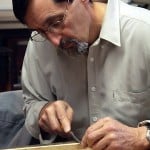Record no7 jointer not taking even shavings
Welcome! / Forums / General Woodworking Discussions / Tools and Tool Maintenance/Restoration / Record no7 jointer not taking even shavings
- This topic has 6 replies, 5 voices, and was last updated 11 years, 1 month ago by
billstennett.
-
AuthorPosts
-
9 March 2013 at 10:28 pm #9089
Hi all I have acquired an old (I think late 1950’s) record jointer in pretty good condition. However my problem is that however I adjust it it will always take thicker shavings on the edges than in the middle. I have squared and sharpened the blade and lapped the sole but still no luck I’m guessing that it is something to do with the sole not being flat so I’ll keep lapping -but I just thought I’d ask if anyone has any experience of a problem like this? Any thoughts on how to sort this out much appreciated Cheers Bill I

Bill, have a look in the thread I posted about my stanley no 7 jointer. Ken posted a link to an article about planes and flat soles. Basically the toe, mouth and the heel should be kinda level. I’ve sharpened the blade on mine using Pauls method with the rounded corners/ slight camber and it works a treat. One trick I found is I don’t particularly rely on the lateral adjust, I use a little hammer and lightly lightly tap the blade side to side for adjusting. I find I can control the lateral much easier.
There you go guys………..http://www.handplane.com/66/thoughts-on-hand-plane-sole-flatness/
10 March 2013 at 9:56 pm #9139Thanks for the advice.
I guess when I said I had already lapped the sole what I really meant was that I had had a fairly half-hearted go at it! I had used coarse paper (60 – 80 grit) asnd when I managed to remove my pen marks from the sole I assummed that was job done – Doh!
After reading the thread mentioned above I thought about it and realised that I needed to go to finer grit. Lapping the sole with 120 showed up more unevenness and, in particular a small but not insignificant high spot in front of the the middle of the mouth. So this is probably the cause of the uneven shavings.
I speant a few hours on it (yes yes I know I should get out more) and it has made a difference. I’ll keep going but it looks like lapping the sole of a jointer takes ages – who knew?
In case it of use to anyone else I was using 120 grit paper on a granite worktop cutoff.
Hopefully with a bit more effort I can get this working well and get on with making some stuff! Despite the effort, there is something quite satisfying about all of this; I guess buying a new jointer would have been easier but where’s the history, where’s the romance in that? If i needed it to make a living that might be different but at the moment I just at the start of my journey.
cheers,
Bill
 10 March 2013 at 11:00 pm #9141
10 March 2013 at 11:00 pm #9141Hi Bill,
I’ve never restored a jointer before, only #5 and now I’m working on #4. What I know from reading different posts – it’s hard to do it due to the size of the jointer. You have to make sure the surface you use for flattening is dead flat, in your case it’s granite cutoff. Mine is from Lee Valley, but only 9″-12″. Before I start flattening, I place a filler gauge under the plane and try to drag the plane to see if gauge moves or stays under the plane. After that I use a ruler (from Starrett’s combination square) to check for high or low spots. Then I draw lines (net style with Sharpie) and start working with sandpaper, periodically checking how lines disappear.
Did you check the flatness of the frog and points where it contacts the sole? Sometimes there’s paint there. Not trying to be smart, just going through possibilities 🙂 I totally agree with you – restoration process is fun))
Cheers Serhiy
 12 March 2013 at 10:11 am #9186
12 March 2013 at 10:11 am #9186Hello everyone:
I thought I would make you aware that long planes are rarely flat, even high end ones do change with heat exhanges and I actually rarely find long planes dead true and flat.
As a boy no one had a flat plane per se.I learned later on that the men I worked with ‘flexed’ their plane to flatness using the handles. Remember you can easily flex your sole by pulling apart the handles or pushing them together. One causes a belly , the other and hollow. the main reason for flattening is not so much to straighten but to get the sole in wind so their is not twist in it. I see lots of people ‘bull-dogging’ their plane to the granite flat-stone as they flatten. I remember my apprentice, John, doing this and he kept coming away from the task with a bellied sole that then created a hollow. I showed him to rely on pressing on the sole rather than the handles and he got great results after that.12 March 2013 at 6:16 pm #9198Hi Paul,
Thank you for jumping in. I’ve been trying to be even handed when lapping and not overdoing the pressure. Also I had read somewhere to keep changing where I hold the plane while lapping – presumably to avoid the the effects you describe of just hanging on to the handles.
I’ve also noted your comments about long planes hardly ever being truly flat. A good tip so I won’t try to make mirror out of it – I just want to get to the place where I can get an even shaving and enjoy using it.
Thanks for the advice
-
AuthorPosts
- You must be logged in to reply to this topic.
